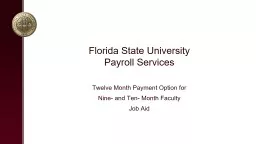PPT-Net Pay Calculator PowerPoint Presentation
Author : trish-goza | Published Date : 2018-09-21
What is Net Pay Calculator Net Pay Calculator is an Excel spreadsheet designed to determine the effect of certain payroll changes on tax withholding and net pay
Presentation Embed Code
Download Presentation
Download Presentation The PPT/PDF document "Net Pay Calculator PowerPoint Presentati..." is the property of its rightful owner. Permission is granted to download and print the materials on this website for personal, non-commercial use only, and to display it on your personal computer provided you do not modify the materials and that you retain all copyright notices contained in the materials. By downloading content from our website, you accept the terms of this agreement.
Net Pay Calculator PowerPoint Presentation: Transcript
Download Rules Of Document
"Net Pay Calculator PowerPoint Presentation"The content belongs to its owner. You may download and print it for personal use, without modification, and keep all copyright notices. By downloading, you agree to these terms.
Related Documents














